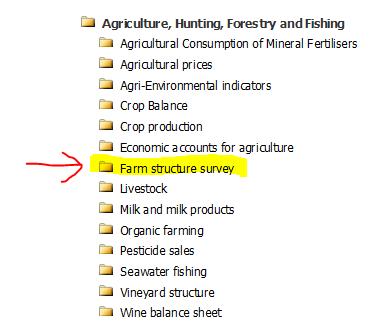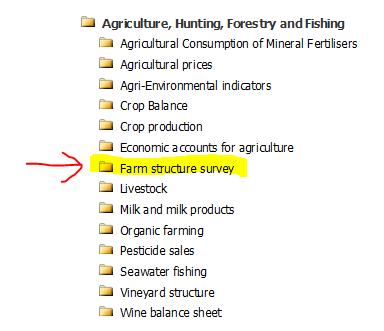| 6. Accuracy and reliability |
Top |
|
|
| 6.1. Accuracy - overall |
| Main sources of error |
| The results of sample surveys are extrapolated with one factor for a wide range of characteristics. Therefore the accuracy of specific variables is usually lower than in special surveys (crop surveys, vineyard surveys, orchard surveys, livestock surveys, and labour force surveys). Since post-stratification is not done for this survey, misclassification was not assessed. Statistics corrects possible errors of measurement using the logic-numeric control. We are trying to avoid the measurement error by training of interviewers and supervisor, control data and process validation. After data entry, extreme values of variables are checked and corrected if necessary. The probability of undercoverage in the FSS is very low since there are not many new agricultural holdings. The unit non-response was one of the main sources of error. |
|
| 6.2. Sampling error |
| Method used for estimation of relative standard errors (RSEs) |
| The method for estimation of RSEs was SAS PROC SURVEYMEANS procedure. We calculated standard errors and coefficients of variation, by using general SAS programs that are used in most of the CBS surveys. |
|
| 6.2.1. Sampling error - indicators |
1. Relative standard errors (RSEs) - in annex
| 2. Reasons for possible cases where precision requirements are applicable and estimated RSEs are above the thresholds |
| The sampling design meets the precision requirements of the Regulation 1166/2008. The a posteriori calculation of the RSEs gives the following deviations: - for the area of plants harvested green in HR04: The main reason is great dispersion in population because stratification did not get the homogeneity of the population by strata. - for the area of pasture excluding rough grazings in HR03: The main reason is scattered population due to changes since the last update framework for sampling - for the area of pasture excluding rough grazings in HR04: The main reason is scattered population due to changes since the last update framework for sampling - for the number of dairy cows in HR03: The main reason is scattered population due to changes since the last update framework for sampling. - for the number of dairy cows in HR04: The main reason is scattered population due to changes since the last update framework for sampling. - for the number of other bovine animals in HR04: The main reason is scattered population due to changes since the last update framework for sampling. |
Annexes:
6.2.1-1. Relative standard errors FSS2016
|
| 6.3. Non-sampling error |
See below |
| 6.3.1. Coverage error |
| 1. Under-coverage errors |
| The probability of undercoverage in the FSS is very low since there are not many new agricultural holdings. We consider that the number of agricultural households decreases, and that the number of newly established farms is not in balance, i.e., that those who go out of farming are more numerous. All important new farms are included in administrative registers and were consequently included into the list. |
| 2. Over-coverage errors |
| With the aid of questions in the questionnaire we also recorded the reasons for the non-eligibility. This helps us for updating the Statistical Register of Agricultural Holdings (exclusion of ineligible family farms from the frame).We assume that the next Agricultural Census will give us the real degree of overcoverage when the entire frame will be updated again. Weighting factors were calculated on the basis of eligibility status of agricultural holdings, with the formula (number of eligible respondents + number of eligible non-respondents + number of units with unknown eligibility)/ number of eligible respondents - on the level of strata. |
| 2.1 Multiple listings |
| Altogether 52 family farms were listed twice. They were treated as ineligible. |
| 3. Misclassification errors |
| Since post-stratification is not done in Croatia, misclassification was not assessed. However, results of the FSS prove that there were no problems with misclassification. |
| 4. Contact errors |
| There were altogether 2,1% of total sample not contacted farms (the holder could not be reached - there was nobody at the address, the person was not known at the address, the address of the holding was incomplete or the telephone number of these family farms did not exist). The extrapolation factor is adjusted for these farms. |
| 5. Other relevant information, if any |
| Not available. |
|
| 6.3.1.1. Over-coverage - rate |
| Over-coverage - rate |
| Over-coverage rate was calculated as follows: Over-coverage rate = out-of-scope units / (eligible units + number of units with unknown eligibility + out-of-scope units) The share of units that were included in the frame and it turned out that they didn’t belong to the target population was 3,06%. |
|
| 6.3.1.2. Common units - proportion |
[Not requested] |
| 6.3.2. Measurement error |
| Characteristics that caused high measurement errors |
| Statistics corrects possible errors of measurement using the logic-numeric control. We are trying to avoid the measurement error by training of interviewers and supervisors, control data and process validation. Characteristics that are complicated for both respondents and interviewers are related to labour force, more than 50% of production self-consumed by the holder and importance of other gainful activities directly related to the holding. After data entry, extreme values of variables are checked and corrected if necessary. |
|
| 6.3.3. Non response error |
| 1. Unit non-response: reasons, analysis and treatment |
| Unit non-response was treated with re-weighting. The main reasons for non-response were refusals because of the following reasons: • dissatisfaction with the current agricultural policy in Croatia, • problems with unsolved ownership (official procedures regarding succession can be very long), • general refusal because of other reasons. The survey results are weighted in order to adjust for the sampling design and for unit non-response to produce valid results for the target population. Unit non-response is accounted by re-weighting.This will automatically adjust the sample weights of the respondents to compensate for unit non-response. So, CBS experts have used the basic method for adjusting for the sampling design and for unit non-response and they calculated weights only by using module SAS-base. The bias risks associated with non-response are low because of the very low non-response rate (4,6%). |
| 2. Item non-response: characteristics, reasons and treatment |
| In the process of data validation, we considered national rules as well as validation rules for EUROFARM. There were no specific units discovered which had not responded to a particular item. |
|
| 6.3.3.1. Unit non-response - rate |
| Unit non-response - rate |
| Unit non response rate was calculated as follows: Unit non response rate = (1-(number of eligible respondents / (number of eligible respondents + number of eligible non-respondents + number of units with unknown eligibility)))*100 Unit non-response rate amounts to 4.6 %. |
|
| 6.3.3.2. Item non-response - rate |
| Item non-response - rate |
| Not available. All known cases of non-response items were solved by re-interviewing or by imputation. |
|
| 6.3.4. Processing error |
| 1. Imputation methods |
| Imputation of missing data has been done for some organic characteristics. The Cold-deck imputation method was used to "fill-in" the missing item. |
| 2. Other sources of processing errors |
Data on the number of corrections were not collected during data processing.
Follow-up interviews were used for corrections. |
| 3. Tools used and people/organisations authorised to make corrections |
| Data entry and checking of data (logic-numeric control incorporated in questionnare, SQL). All the corrections are done in Agriculture, forestry, fishery and environment Directorate/Crop production statistics and Register of Agricultural Holdings Unit. |
|
| 6.3.4.1. Imputation - rate |
| Imputation - rate |
| 2 % regarding organic farming characteristics. |
|
| 6.3.5. Model assumption error |
[Not requested] |
| 6.4. Seasonal adjustment |
[Not requested] |
| 6.5. Data revision - policy |
| Data revision - policy |
| Revision Policy of the Croatian Bureau of Statistics is based on the principles of the European Statistics Code of Practice. Revision policy of the Croatian Bureau of Statistics distinguishes three types of revisions: regular revisions, major revisions and unscheduled revisions. Unplanned revision of the FSS 2016 may be carried out. In any case it is necessary to clarify the reasons for a revision (mistake in data sources or calculations or due to the unexpected changes in the methodology or data sources). |
|
| 6.6. Data revision - practice |
| Data revision - practice |
| Data revision is not planned so far. |
|
| 6.6.1. Data revision - average size |
[Not requested] |



